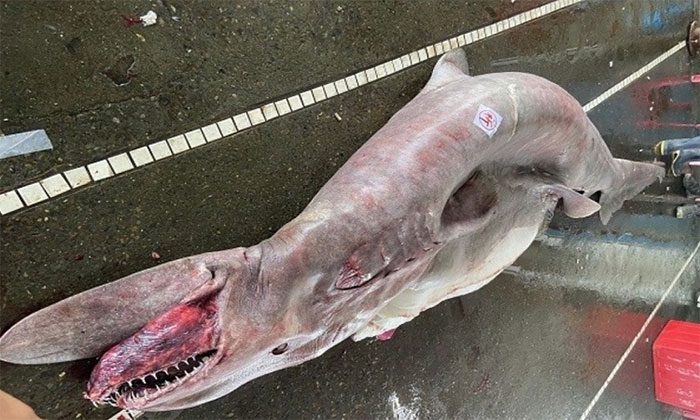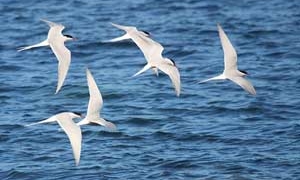A fishing trawler caught an 800kg pregnant goblin shark with six pups off the northeastern coast of Taiwan.
The pregnant goblin shark with a swollen belly. (Video: Taiwan Ocean Art Museum).
Fishermen pulled the unusual shark from the deep sea on June 13. This is the largest goblin shark ever caught in these waters. Initially, they intended to sell it to a restaurant, according to the Taiwan Ocean Art Museum, which is currently housing the specimen. The museum has purchased it for future educational display.
The goblin shark (Mitsukurina owstoni) is among the most bizarre shark species found in the ocean. This long-snouted creature is a demersal species, meaning it lives in waters close to the seabed at depths of 1,200 meters. Its jaws, filled with needle-like teeth, extend outward to capture prey such as bony fish, squid, and crustaceans, before retracting to a resting position beneath its eyes, according to the Australian Museum. The goblin shark is the only living member of the Mitsukurinidae family, which originated 125 million years ago during the Cretaceous period. Comparisons between current specimens and prehistoric fossils show that they have changed little over time.

The 4.7-meter long shark with a swollen belly containing six pups.
While goblin sharks are typically gray, the specimen pulled from the deep sea may appear pinkish-purple if its blood vessels were damaged by fishing equipment. Images from the museum’s Facebook page show the 4.7-meter-long shark with a swollen belly containing six pups. Goblin sharks reproduce through internal fertilization and are ovoviviparous, meaning females carry eggs inside their bodies until they hatch, after which they give birth to live young. The fishermen accidentally caught the shark while trawling on the sea floor.
Marine conservationists condemn this fishing method as it cannot distinguish what is caught, resulting in large quantities of unintended marine life being captured and subsequently discarded. Research published in the journal Fisheries Research indicates that trawling accounts for nearly 60% of the annual bycatch in fishing activities, equivalent to 6 million tons.
Trawling also destroys the seabed, disrupting animal habitats, stirring up sediments, altering chemical compositions in the water, and reducing the light necessary for photosynthesis in plants. This fishing method is banned in some parts of the world, including 90% of the seabed along the U.S. West Coast.
Goblin sharks are rarely observed or photographed in the wild. Most of what researchers know about them comes from bycatch specimens. They are not listed as a threatened species due to human activities.




















































